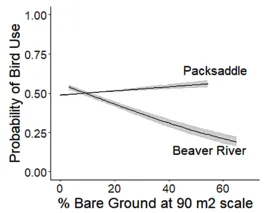Quail Ecology and Management Project Report for February 2021
Provided by Oklahoma Cooperative Fish and Wildlife Research Unit, Oklahoma State University
No quail transmitters were deployed or recovered in February. The last transmitters that were still transmitting became stationary in January, indicating that the quail had perished. Thus, no new quail locations were obtained in February.
In total, 64,948 individual locations from live quail were collected since the launch of the first transmitter in May 2018. The field work has ended for the quail component, and the students are working on analyzing the data and writing their theses and dissertations.
For the invertebrate and seed component, data collection will continue through spring.
In addition to continuing their analyses of collected data and working on their theses, Jennifer Knutson, John McQuaig and Landon Neumann have been preparing a number of manuscripts for publication in scientific journals. These include the effects of woody vegetation height on the density of quail and other members of the grassland bird community; the response of vegetation and animal use to prescribed burning; and how bobwhite movement activity varies with time of day, season and weather.

Using telemetry data from the previous quail study along with land cover data from the Rangeland Analysis Platform, Samantha Cady examined the relationship between habitat use and percent cover of woody shrubs, trees and bare ground, and whether these selection patterns varied between Packsaddle and Beaver River wildlife management areas.
The results showed that the direction, magnitude and scale of northern bobwhite habitat selection is site-dependent at Packsaddle and Beaver River. Specifically, there was a strong selection against trees at Packsaddle and no relationship between bobwhites and trees at Beaver River (Figure 1). Additionally, there was selection for shrub cover at both WMAs, however bobwhites selected for shrubs more strongly at Beaver River than they did at Packsaddle (Figure 1). Interestingly, bobwhites selected for bare ground at Packsaddle, but selected against bare ground at Beaver River (Figure 1).

The resulting paper has been submitted to “Ecology and Evolution” for publication and is currently in peer review.
In the invertebrate research, Jacob Reeves submitted a manuscript on the effects of prescribed burns and disking on invertebrate prey of bobwhite quail to “Rangeland Ecology and Management” for publication consideration. We have also been working on his other manuscript on the nutritional quality of arthropod prey of bobwhites to prepare it for submission.
In addition, Reeves has begun processing data from his January fieldwork at Packsaddle WMA. The data on raptor observations in the burn areas do not seem to show an overall effect of prescribed burns on raptor activity.
In the north block of burn plots, Reeves recorded 23 raptor observations in the 2019 burn (two growing seasons post-burn), eight raptors in the 2020 burn (one growing season post-burn) and eight raptors in the unburned area (more than two growing seasons post-burn).
In the south block, there were overall fewer raptor observations with seven raptors observed in the 2019 burn, eight raptors in the 2020 burn, and 12 raptors in the unburned area.
Northern harriers were observed more than twice as frequently as any other raptor, followed by American kestrels, merlins, and red-tailed hawks. The plan for the future is for raptor observation locations to be overlaid on a GIS-interpolated map of seed nutrient availability for bobwhites to assess correlations between food availability and raptor activity.
Finally, Reeves has begun processing seed samples collected during his January fieldwork and has also been planning for the spring field season.
(This project is funded in by the Oklahoma Department of Wildlife Conservation, Federal Aid Project F18AF001-10: Quail Ecology and Management II.)